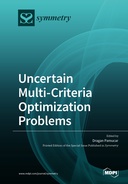Explore

Uncertain Multi-Criteria Optimization Problems
0 Ungluers have
Faved this Work
Login to Fave
Most real-world search and optimization problems naturally involve multiple criteria as objectives. Generally, symmetry, asymmetry, and anti-symmetry are basic characteristics of binary relationships used when modeling optimization problems. Moreover, the notion of symmetry has appeared in many articles about uncertainty theories that are employed in multi-criteria problems. Different solutions may produce trade-offs (conflicting scenarios) among different objectives. A better solution with respect to one objective may compromise other objectives. There are various factors that need to be considered to address the problems in multidisciplinary research, which is critical for the overall sustainability of human development and activity. In this regard, in recent decades, decision-making theory has been the subject of intense research activities due to its wide applications in different areas. The decision-making theory approach has become an important means to provide real-time solutions to uncertainty problems. Theories such as probability theory, fuzzy set theory, type-2 fuzzy set theory, rough set, and uncertainty theory, available in the existing literature, deal with such uncertainties. Nevertheless, the uncertain multi-criteria characteristics in such problems have not yet been explored in depth, and there is much left to be achieved in this direction. Hence, different mathematical models of real-life multi-criteria optimization problems can be developed in various uncertain frameworks with special emphasis on optimization problems.
This book is included in DOAB.
Why read this book? Have your say.
You must be logged in to comment.
Rights Information
Are you the author or publisher of this work? If so, you can claim it as yours by registering as an Unglue.it rights holder.Downloads
This work has been downloaded 138 times via unglue.it ebook links.
- 138 - pdf (CC BY) at Unglue.it.
Keywords
- AHP
- B2C e-commerce factors
- bi-objective programming
- carbon emissions
- chance constrained programming model
- chance constraint
- China
- circuit breakers
- Classification
- comparison measure
- complex networks
- conjoint analysis
- consistency weights
- core set
- crisp probability
- criteria importance
- CRITIC
- cubic m-polar fuzzy aggregation operators with P-order (R-order)
- cubic m-polar fuzzy set
- Data envelopment analysis
- DEA
- Decision making
- decision tree
- decision-making methods
- DEMATEL
- Dimensionality Reduction
- disjoint
- distributionally robust
- DMAIC
- Dombi’s operations
- Economics, finance, business & management
- Efficiency
- Einstein operators
- Entropy
- evolutionary algorithms
- Experimental design
- Expert Knowledge
- FAHP
- failure mode and effects analysis
- fuzzy AHP
- fuzzy EDAS
- Fuzzy logic
- Fuzzy PIPRECIA
- fuzzy preference relation (FPR)
- fuzzy set
- fuzzy theory
- geometric aggregation operators based on generalized and group-generalized parameters
- Granular computing
- green supply chain management
- grey relational analysis
- group decision-making (GDM)
- hazardous materials
- hesitant fuzzy preference relation (HFPR)
- Hurwitz’s criterion
- hybrid intelligent algorithm
- incomplete fuzzy preference relation (IFPR)
- Industry & industrial studies
- Industry 4.0
- influence diagrams
- information propagation
- Information technology industries
- intermodal transportation
- interval probability
- interval-valued
- intuitionistic fuzzy set
- intuitionistic fuzzy sets
- IoT
- Jensen–Shannon divergence
- Laplace’s criterion
- Latent Semantic Analysis (LSA)
- linear Diophantine fuzzy set
- linear Diophantine fuzzy soft rough set
- Machine learning
- MCDA
- MCDA benchmark
- MCDM
- Media, information & communication industries
- meta-heuristic algorithm
- mining methods
- multi criteria decision analysis (MCDA)
- Multi-Attribute Decision Making (MADM), criteria selection
- multi-criteria decision making
- multi-criteria decision-analysis
- multi-criteria decision-making
- multi-criteria group decision making
- multi-criteria problems
- multi-objective planning
- multiple criteria decision-making (MCDM)
- multiple granulation
- multiple-criteria decision-making
- multiplicative preference relation (MPR)
- normal hesitant fuzzy preference relation (NHFPR)
- normalization
- optimization
- ordered information system
- outsourcing provider
- platform selection
- port-hinterland transportation system
- prioritized aggregation operators
- PROMETHEE II
- PROMETHEE-II
- Prospective MADM
- q-ROFNs
- q-rung orthopair fuzzy numbers
- q-rung orthopair fuzzy prioritized weighted average operator
- q-rung orthopair fuzzy prioritized weighted geometric operator
- q-Rung orthopair fuzzy sets
- railway
- Representation
- reverse supply chain
- robust optimization
- SCOR model
- service quality
- SFA
- shapley function
- SIMUS
- SIR technique
- Six Sigma (6σ)
- Social networks
- soft rough linear Diophantine fuzzy set
- solar panel systems
- steel making industry
- step-wise weight assessment ratio analysis
- subjective and objective teacher efficiency
- Sustainable development
- sustainable supplier selection
- Text Mining
- textile and garments industry
- the COMET method
- TL-consistency
- TODIM
- TOPSIS
- TOPSIS-Grey
- transport plan
- transport policy
- uncertain data
- uncertain demand
- uncertainty
- uncertainty theory
- underground mines
- upper reduct and lower reduct
- vehicle fleet
- vehicle route model (VRP)
- Viral marketing
- water loss management
- website
- weight restrictions
- weighting
- Yangtze River Economic Belt
- Z-number theory
- Łukasiewicz consistency
Links
DOI: 10.3390/books978-3-0365-1573-1Editions

